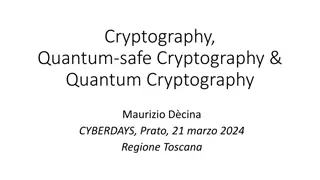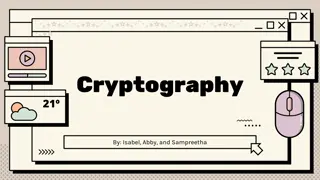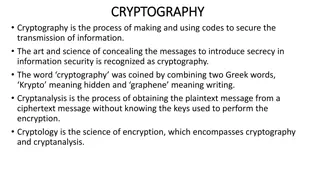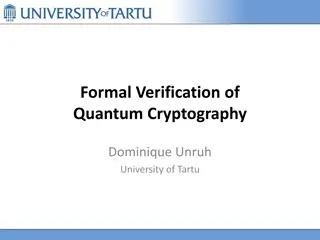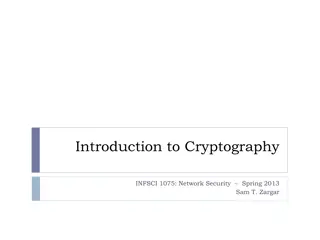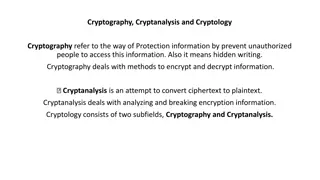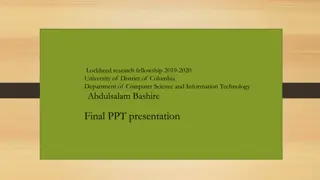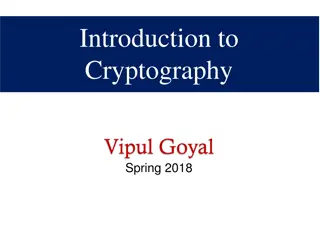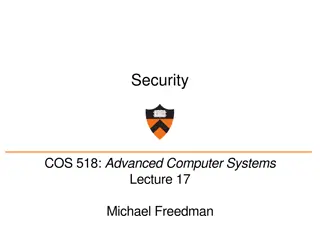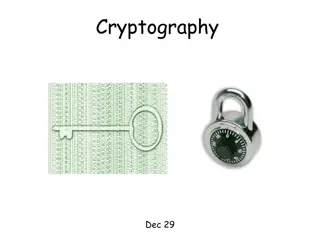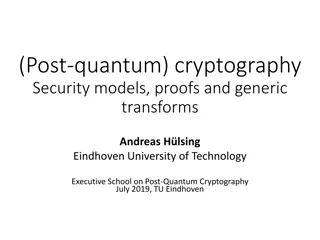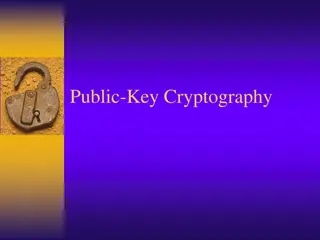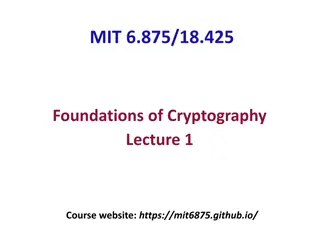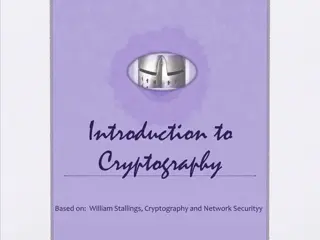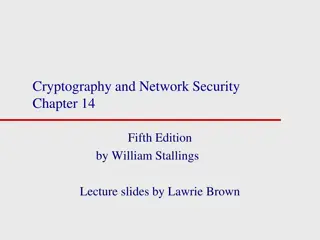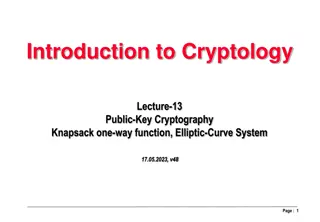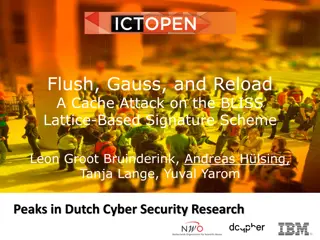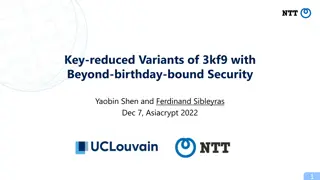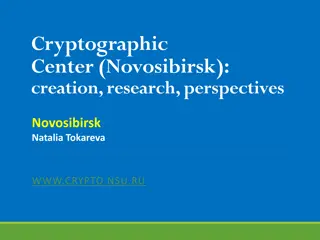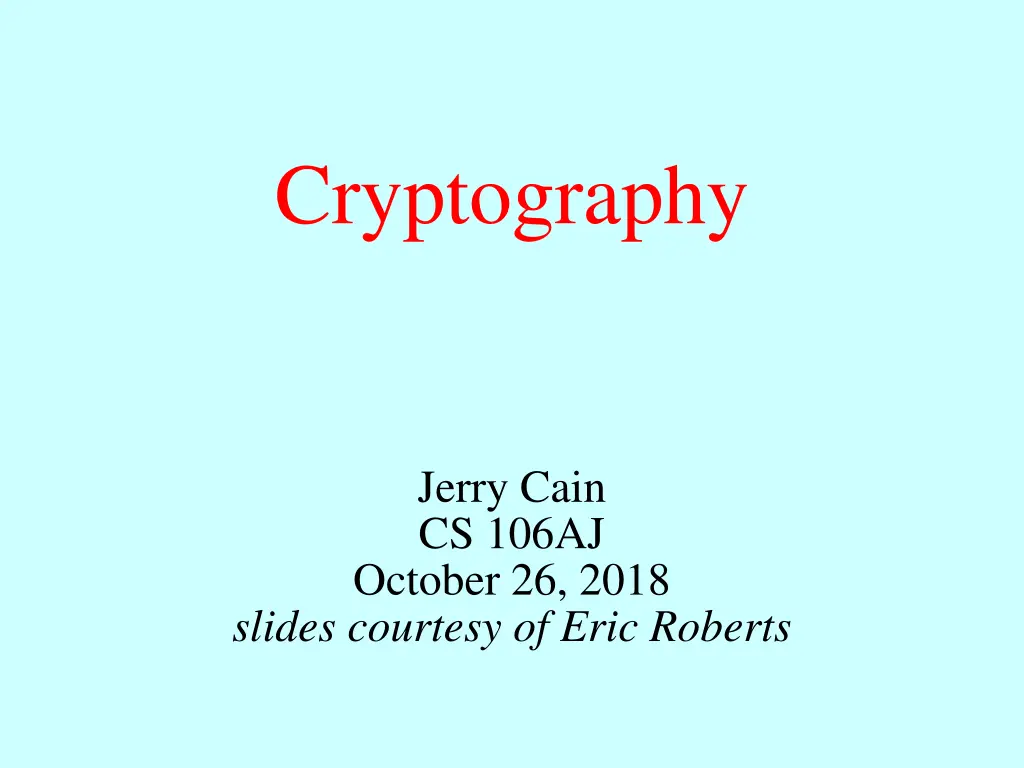
Alan Turing and Cryptography History Revealed
Explore the fascinating history of Alan Turing, his contributions to computer science, and the world of cryptography. Delve into the myths and truths behind The Imitation Game movie and learn about implementing a Caesar Cipher for encryption. Uncover the legacy of a brilliant mind lost too soon.
Download Presentation

Please find below an Image/Link to download the presentation.
The content on the website is provided AS IS for your information and personal use only. It may not be sold, licensed, or shared on other websites without obtaining consent from the author. If you encounter any issues during the download, it is possible that the publisher has removed the file from their server.
You are allowed to download the files provided on this website for personal or commercial use, subject to the condition that they are used lawfully. All files are the property of their respective owners.
The content on the website is provided AS IS for your information and personal use only. It may not be sold, licensed, or shared on other websites without obtaining consent from the author.
E N D
Presentation Transcript
Cryptography Jerry Cain CS 106AJ October 26, 2018 slides courtesy of Eric Roberts
Alan Turing The film The Imitation Game celebrated the life of Alan Turing, who made many important contributions in many areas of computer science, including hardware design, computability, and AI. During World War II, Turing headed the mathematics division at Bletchley Park in England, which broke the German Enigma code a process you ll simulate in Assignment #5. Tragically, Turing committed suicide in 1954 after being convicted on a charge of "gross indecency" for homosexual behavior. Prime Minister Gordon Brown issued a public apology in 2009. Alan Turing (1912-1954)
The Imitation Game Alan Turing s wartime work is now more widely known because of the movie The Imitation Game. Unfortunately, the movie got much of the history wrong.
Encryption Twas brillig, and the slithy toves, Did gyre and gimble in the wabe: Doo plpvb zhuh wkh erurjryhv, Lfr gax wvwx clgat vngeclzx. A B CD E F G H I J K L M NOPQR S T U VW XY Z L Z DR X P E A J Y BQW F V I HC TGNO M K S U Twas brillig, and the slithy toves, Did gyre and gimble in the wabe: All mimsy were the borogoves, And the mome raths outgrabe. Twas brillig, and the slithy toves, Did gyre and gimble in the wabe: All mimsy were the borogoves, And the mome raths outgrabe.
Implementing a Caesar Cipher str "Et tu, Brute?" result "Rg gh, O" "Rg gh, Oe" "Rg gh, Oeh" "Rg gh, Oehg" "Rg gh, Oehgr" "Rg gh, Oehgr?" key -13 13 i code 69 116 116 117 66 114 117 116 101 base 65 97 97 97 65 97 97 97 97 ch "" "R" "Rg" "Rg " "Rg g" "Rg gh" "Rg gh," "Rg gh, " 10 11 12 13 0 1 2 3 4 5 6 7 8 9 "E" "R" "t" "g" " " "t" "g" "u" "h" "," " " "B" "O" "r" "e" "u" "h" "t" "g" "e" "r" "?" > caesarCipher("Et tu, Brute?", -13) Rg gh, Oehgr?
Cryptograms A cryptogram is a puzzle in which a message is encoded by replacing each letter in the original text with some other letter. The substitution pattern remains the same throughout the message. Your job in solving a cryptogram is to figure out this correspondence. One of the most famous cryptograms was written by Edgar Allan Poe in his short story "The Gold Bug." In this story, Poe describes the technique of assuming that the most common letters in the coded message correspond to the most common letters in English, which are E, T, A, O, I, N, S, H, R, D, L, and U. Edgar Allan Poe (1809-1849)
Poes Cryptogram Puzzle 53 305))6*;4826)4 )4 );806*;48 8 60))85;1 (;: *8 83(88)5* ;46(;88*96* ?;8)* (;485);5* 2:* (;4956*2(5* 4)8 8*;4069285);)6 8)4 ;1( 9;48081;8:8 1;48 85;4)485 528806*81( 9;48;(88;4( ?34;48)4 ;161;:188; ?; 33 26 19 16 16 13 12 11 10 8 ; 4 ) * 5 6 ( 1 0 9 2 : 3 ? 8 8 6 5 5 4 4 3 2 1 1 53 305))6*;4826)4 )4 );806*;48 8 60))85;1 (;: *8 83(88)5* ;46(;88*96* ?;8)* (;485);5* 2:* (;4956*2(5* 4)8 8*;4069285);)6 8)4 ;1( 9;48081;8:8 1;48 85;4)485 528806*81( 9;48;(88;4( ?34;48)4 ;161;:188; ?; ?34;4E)4 ;161;:1EE; ?; ?3HTHE)H T161T:1EET ?T OUGHTHESHOTFIFTYFEETOUT 53 305))6*;4E26)4 )4 );E06*;4E E 60))E5;1 (;: *E E3(EE)5* ;46(;EE*96* ?;E)* (;4E5);5* 2:* (;4956*2(5* 4)E E*;40692E5);)6 E)4 ;1( 9;4E0E1;E:E 1;4E E5;4)4E5 52EE06*E1( 9;4E;(EE;4( 1THE E5TH)HE5 52EE06*E1( 9THET(EETH( FTHEDEATHSHEADABEELINEFROMTHETREETHR 53 305))6*THE26)H )H )TE06*THE E 60))E5T1 (T: *E E3(EE)5* TH6(TEE*96* ?TE)* (THE5)T5* 2:* (TH956*2(5* H)E E*TH0692E5)T)6 E)H T1( 9THE0E1TE:E ENTHLIMBEASTSIDESHOOTFROMTHELEFTEYEO AGOODGLASSINTHEBISHOPSHOSTELINTHEDEV ILSSEATFORTYONEDEGREESANDTHIRTEENMIN UTESNORTHEASTANDBYNORTHMAINBRANCHSEV
Exercise: Letter-Substitution Cipher Poe s cryptogram is an example of a letter-substitution cipher, in which each letter in the original message is replaced by some different letter in the coded version of that message. In this type of cipher, the key is usually presented as a sequence of 26 letters that shows how each of the letters in the standard alphabet are mapped into their enciphered counterparts: JavaScript Console > const KEY = "QWERTYUIOPASDFGHJKLZXCVBNM"; > encrypt("SECRET MESSAGE", KEY) LTEKTZ DTLLQUT
Important Properties of the Enigma Code The decryption team at Bletchley was able to exploit the following facts about the Enigma machine: The encoding is symmetrical. The Enigma machine can never map a character into itself. The steckerboard does not affect the transformation pattern of the rotors, but only the characters to which the outputs of that rotor are assigned. The codebreakers were also helped by the fact that the Germans were often both careless and overconfident. In believing they had an unbreakable encoding machine, they failed to take adequate measures to safeguard the integrity of their communications.
Breaking the Enigma Code The most common technique used at Bletchley Park was the known-plaintext attack, in which the codebreakers guess that a particular sequence of characters exists somewhere in the decoded message. A sequence of characters that you guess is part of the plaintext is called a crib. The Imitation Game gives the mistaken impression that Alan Turing came up with the idea of a crib during the war. The value of a crib has been known since antiquity. The 2001 movie Enigma offers a much more accurate view of why cribs are important and how codebreakers use them.

